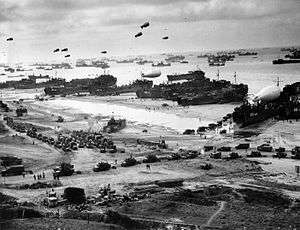Barrage balloon
A barrage balloon is a large unmanned tethered kite balloon used to defend ground targets against aircraft attack, by raising aloft steel cables which pose a severe collision risk to aircraft, making the attacker's approach more difficult. The design of the kite balloon, having a shape and cable bridling which stabilise the balloon and reduce drag, meant that it could be operated with more wind than a circular balloon could. Some examples carried small explosive charges that would be pulled up against the aircraft to ensure its destruction. Barrage balloons are not practical against very high altitude flying aircraft, due to the weight of the long cable required.

First World War
France, Germany, Italy and the United Kingdom used barrage balloons in the First World War. Sometimes, especially around London, several balloons were used to lift a length of "barrage net", in which a steel cable was strung between the balloons and many more cables hung from it. These nets could be raised to an altitude comparable to the operational ceiling (15,000 ft / 4,500 m) of the bombers of that time period. By 1918 the barrage balloon defences around London stretched for 50 miles (80 km), and captured German pilots expressed great fear of them.[1]
Second World War

In 1938 the British Balloon Command was established to protect cities and key targets such as industrial areas, ports and harbours. Balloons were intended to defend against dive bombers flying at heights up to 5,000 feet (1,500 m), forcing them to fly higher and into the range of concentrated anti-aircraft fire: anti-aircraft guns could not traverse fast enough to attack aircraft flying at low altitude and high speed. By the middle of 1940 there were 1,400 balloons, a third of them over the London area.
While dive-bombing was a devastatingly effective tactic against undefended targets, such as Guernica and Rotterdam, dive-bombers were very vulnerable to attack by fighter aircraft while performing a dive, and their use in this role by Germany against the UK with its effective Royal Air Force was rapidly discontinued. Balloons proved to be of little use against the German high-level bombers with which the dive-bombers were replaced, but continued to be manufactured nonetheless, until there were almost 3,000 in 1944. They proved to be mildly effective against the V-1 flying bomb, which usually flew at 2,000 feet (600 m) or lower but had wire-cutters on its wings to counter balloons. 231 V-1s are officially claimed to have been destroyed by balloons.[2]
The British added two refinements to their balloons, "Double Parachute Link" (DPL) and "Double Parachute/Ripping" (DP/R). The former was triggered by the shock of an enemy bomber snagging the cable, causing that section of cable to be explosively released complete with parachutes at either end; the combined weight and drag bringing down the aircraft. The latter was intended to render the balloon safe if it broke free accidentally. The heavy mooring cable would separate at the balloon and fall to the ground under a parachute; at the same time a panel would be ripped away from the balloon causing it to deflate and fall independently to the ground.[3]
In January 1945, during Royal Navy Fleet Air Arm raids on the Palembang oil refineries, the British aircrews were surprised by massive use of barrage balloons in the Japanese defences. These were spherical and smaller than the British type. One Grumman Avenger was destroyed, and crew killed, from striking a balloon cable.[4]
Power line disruption
In 1942 Canadian and American forces began joint operations to protect the sensitive locks and shipping channel at Sault Ste. Marie along their common border among the Great Lakes against possible air attack.[5] During severe storms in August and October 1942 some barrage balloons broke loose, and the trailing cables short-circuited power lines, causing some localised disruption to mining and manufacturing. In particular, metals production was disrupted. Canadian military historical records indicate that one of the more serious incidents, known as "The October Incident", caused an estimated loss of 400 tons of steel and 10 tons of ferro-alloys. The winter weather also, apparently, played a part.
As a result, balloons were stored during the winter months and training was improved. Lessons learned from breakaway balloons led to Operation Outward, the intentional release of balloons trailing conductive cables to disrupt power supplies on the occupied European mainland.
Post-war nuclear weapon tests
After the war, some surplus barrage balloons were used as tethered shot balloons for nuclear weapon tests throughout most of the period when nuclear weapons were tested in the atmosphere. The weapon or shot was carried to the required altitude slung underneath the barrage balloon, allowing test shots in controlled conditions at much higher altitudes than test towers. Several of the tests in the Operation Plumbbob series were lifted to altitude using barrage balloons.
See also
References
- Ege, L. "Balloons and Airships", Blandford (1973).
- "Barrage Balloons for Low-Level Air Defense". Air & Space Power Journal. Summer 1989. Archived from the original on 2007-08-12. Retrieved 2007-04-16.
- RAF Museum online exhibition "Air Diagrams"
- Iredale, W. The Kamikaze Hunters 2015 pp189-208 ISBN 9780230768192
- "Protecting Steel Lifeline / Barrage balloon goes aloft at Sault Ste. Marie, Mich., to protect Soo canal against possible air raids..." [photo caption], The Lima News [Lima, OH], 9 Apr. 1942, p. 3.
External links
| Wikimedia Commons has media related to Barrage balloons. |